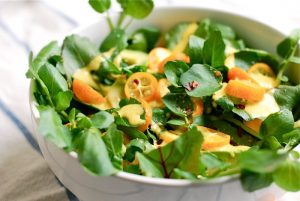 Watercress is an aquatic plant species with the botanical name Nasturtium officinale. This should not be confused with the quite different group of plants with the common name of nasturtium, botanical name Tropaeolum.
Watercress is an aquatic plant species with the botanical name Nasturtium officinale. This should not be confused with the quite different group of plants with the common name of nasturtium, botanical name Tropaeolum.
Watercress is a rapidly growing, aquatic or semi-aquatic, perennial plant native to Europe and Asia, and one of the oldest known leaf vegetables consumed by humans. It is a member of the family Brassicaceae, botanically related to garden cress, mustard, radish and wasabi—all noteworthy for their piquant flavor.
The hollow stems of watercress will float; the leaf structure is pinnately compound. Small, white and green flowers are produced in clusters and are frequently visited by insects, especially hoverflies such as Eristalis flies.
Cultivation of watercress is practical on both a large-scale and a garden-scale. Being semi-aquatic, watercress is well-suited to hydroponic cultivation, thriving best in water that is slightly alkaline. It is frequently produced around the headwaters of chalk streams. In many local markets, the demand for hydroponically grown watercress exceeds supply, partly because cress leaves are unsuitable for distribution in dried form, and can only be stored fresh for a short period.
 Watercress can be sold in supermarkets in sealed plastic bags, containing a little moisture and lightly pressurised to prevent crushing of contents. This has allowed national availability with a once-purchased storage life of one to two days in chilled/refrigerated storage.
Watercress can be sold in supermarkets in sealed plastic bags, containing a little moisture and lightly pressurised to prevent crushing of contents. This has allowed national availability with a once-purchased storage life of one to two days in chilled/refrigerated storage.
Also sold as sprouts, the edible shoots are harvested days after germination. If unharvested, watercress can grow to a height of 50 to 120 centimetres ( 1 1⁄2–4 ft). Like many plants in this family, the foliage of watercress becomes bitter when the plants begin producing flowers.